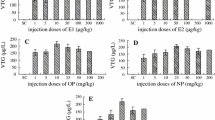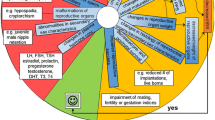Abstract
The method on combined effects of environmental estrogens and mixture environmental risk assessment was discussed. Batch tests were conducted to assess the in vivo potency of mixtures of estrogens using plasma vitellogenin concentrations in male crucian carp (Carassius carassius) as the endpoint. A nonlinear regression was determined on the concentration response relationship for the single chemical of 17β-estradiol (E2), 17α-ethynylestradiol (EE2), 4-tert-octylphenol (OP), bisphenol A (BPA), and that of the mixed compounds at equipotent concentrations (E2-EE2, E2-EE2-OP-BPA), the mixture was tested using a fixed-ratio design. On the basis of statistical selection criteria, the best-fit model is chosen individually for each set of data. Furthermore, the bootstrap methodology is applied for constructing confidence intervals for the estimated effect concentrations. The combined effects of the mixture can be predicted using biomathematical models based on the concentration and potency of the individual mixture components. The finding of non-monotonic dose–response relationship and the combined effects can be accurately predicted in whole range of exposure concentration by the reference models, whereas the outcome of simple effect summation with a great deal of indetermination. Results suggested that there can be a risk of mixture effects. The potential impact of components on mixture would depend predominantly on its concentration, the mixture ratio, and its relative potency. Existing environmental risk assessment procedures are limited in their ability to evaluate the combined effects of chemical mixtures, therefore further improvement is needed.





Similar content being viewed by others
References
Altenburger R, Backhaus T, Boedeker W, Faust M, Scholze M, Grimme LH (2000) Predictability of the toxicity of multiple chemical mixtures to Vibrio fischeri: mixtures composed of similarly acting chemicals. Environ Toxicol Chem 19:2341–2347. doi:10.1897/1551-5028(2000)019<234:POTTOM>2.3.CO;2
Altenburger R, Walter H, Grote M (2004) What contributes to the combined effect of a complex mixture? Environ Sci Technol 38:6353–6362
Altenburger R, Schmitt H, Schüürmann G (2005) Algal toxicity of nitrobenzenes: combined effect analysis as a pharmacological probe for similar modes of interaction. Environ Toxicol Chem 24:324–333
Andersen HR, Andersen AM, Arnold SF, Autrup H, Barfoed M, Beresford NA, Bjerregaard P, Christiansen LB, Gissel B, Hummel R, Jørgensen EB, Korsgaard B, Gevel RL, Leffers H, McLachlan J, Møller A, Nielsen JB, Olea N, Oles-Karasko A, Pakdel F, Pendersen KL, Perez P, Skakkeboek NE, Sonnenschein C, Soto AM, Sumpter JP, Thorpe SM, Grandjean P (1999) Comparison of short-term estrogenicity tests for identification of hormone-disrupting chemicals. Environ Health Perspect 107(suppl 1):89–108
Backhaus T, Altenburger R, Boedeker W, Faust M, Scholze M, Grimme LH (2000) Predictability of the toxicity of a multiple mixture of dissimilarly acting chemicals to Vibrio fischeri. Environ Toxicol Chem 19:2348–2356. doi:10.1897/1551-5028(2000)019<2348:POTTOA>2.3.CO;2
Backhaus T, Altenburger R, Arrhenius Å, Blanck H, Faust M, Finizio A, Gramatica P, Grote M, Junghans M, Meyer W, Pavan M, Porsbring T, Scholze M, Todeschini R, Vighi M, Walter H, Grimme LH (2003) The BEAM-project: prediction and assessment of mixture toxicities in the aquatic environment. Cont Shelf Res 23:1757–1769. doi:10.1016/j.csr.2003.06.002
Brian JV, Harris CA, Scholze M, Backhaus T, Booy P, Lamoree M, Pojana G, Jonkers N, Runnalls T, Bonfà A, Marcomini A, Sumpter JP (2005) Accurate prediction of the response of freshwater fish to a mixture of estrogenic chemicals. Environ Health Perspect 113:721–728
Brian JV, Harris CA, Scholze M, Kortenkamp A, Booy P, Lamoree M, Pojana G, Jonkers N, Marcomini A, Sumpter JP (2007) Evidence of estrogenic mixture effects on the reproductive performance of fish. Environ Sci Technol 41:337–344
Caldwell DJ, Mastrocco F, Hutchinson TH, Länge R, Heijerick D, Janssen C, Anderson PD, Sumpter JP (2008) Derivation of an aquatic predicted no-effect concentration for the synthetic hormone, 17α-ethinylestradiol. Environ Sci Technol 42:7046–7054
Denslow ND, Chow MC, Kroll KJ, Green L (1999) Vitellogenin as a biomarker of exposure for estrogen or estrogen mimics. Ecotoxicology 8:385–398. doi:10.1023/A:1008986522208
Faust M, Altenburger R, Backhaus T, Blanck H, Boedeker W, Gramatica P, Hamer V, Scholze M, Vighi M, Grimme LH (2003) Joint algal toxicity of 16 dissimilarly acting chemicals is predictable by the concept of independent action. Aquat Toxicol 63:43–63
Gong Y, Chin HS, Lim LSE, Loy CJ, Obbard JP, Yong EL (2003) Clustering of sex hormone disruptors in Singapore’s marine environment. Environ Health Perspect 111:1448–1453
Houtman CJ, Houten YKV, Leonards PEG, Brouwer A, Lamoree MH, Legler J (2006) Biological validation of a sample preparation method for ER-CALUX bioanalysis of estrogenic activity in sediment using mixtures of xeno-estrogens. Environ Sci Technol 40:2455–2461
Hutchinson TH, Ankley GT, Segner H, Tyler CH (2006) Screening and testing for endocrine disruption in fish—biomarkers as “signposts”, not “traffic lights”, in risk assessment. Environ Health Perspect 114(suppl 1):106–114
Jobling S, Williams R, Johnson A, Taylor A, Gross-Sorokin M, Nolan M, Tayler CR, Aerle R, Santos E, Brighty G (2006) Predicted exposures to steroid estrogens in U.K. rivers correlate with widespread sexual disruption in wild fish populations. Environ Health Perspect 114(suppl 1):32–39
Junghans M, Backhaus T, Faust M, Scholze M, Grimme LH (2006) Application and validation of approaches for the predictive hazard assessment of realistic pesticide mixtures. Aquat Toxicol 76:93–110. doi:10.1016/j.aquatox.2005.10.001
Kortenkamp A, Altenburger R (1998) Synergisms with mixtures of xenoestrogens: a reevaluation using the method of isoboles. Sci Total Environ 221:59–73
Kortenkamp A, Altenburger R (1999) Approaches to assessing combination effects of oestrogenic environmental pollutants. Sci Total Environ 233:131–140
Lin LL, Janz DM (2006) Effects of binary mixtures of xenoestrogens on gonadal development and reproduction in zebrafish. Aquat Toxicol 80:382–395
Meeuwen JAV, Berg MVD, Sanderson JT, Verhoef A, Piersma AH (2007) Estrogenic effects of mixtures of phyto- and synthetic-chemicals on uterine growth of prepubertal rats. Toxicol Lett 170:165–176. doi:10.1016/j.toxlet.2007.03.003
Pait AS, Nelson JO (2003) Vitellogenesis in male Fundulus heteroclitus (killifish) induced by selected estrogenic compounds. Aquat Toxicol 64:331–342. doi:10.1016/S0166-445X(03)00060-2
Payne J, Schoolze M, Kortenkamp A (2001) Mixtures of four organchlorines enhance human breast cancer cell proliferation. Environ Health Perspect 109:391–397
Ra JS, Lee BC, Chang NI, Kim SD (2006) Estimating the combined toxicity by two-step prediction model on the complicated chemical mixtures from wastewater treatment plant effluents. Environ Toxicol Chem 25:2107–2113
Rajapakse N, Ong D, Kortenkamp A (2001) Defining the impact of weakly estrogenic chemicals on the action of steroidal estrogens. Toxicol Sci 60:296–304
Rajapakse N, Silva E, Kortenkamp A (2002) Combining xenoestrogens at levels below individual no-observed-effect concentrations dramatically enhances steroid hormone action. Environ Health Perspect 110:917–921
Rajapakse N, Silva E, Scholze M, Kortenkamp A (2004) Deviation from additivity with estrogenic mixtures containing 4-Nonylphenol and 4-tert-Octylphenol detected in the E-Screen assay. Environ Sci Technol 38:6343–6352
Rider CV, LeBlanc GA (2005) An integrated addition and interaction model for assessing toxicity of chemical mixtures. Toxicol Sci 87:520–528
Scholze M, Boedeker W, Faust M, Backhaus T, Altenburger R, Grimme LH (2001) A general best-fit method for concentration-response curves and the estimation of low-effect concentrations. Environ Toxicol Chem 20:448–457. doi:10.1897/1551-5028(2001)020<0448:AGBFMF>2.0.CO;2
Silva E, Rajapakse N, Kortenkamp A (2002) Something from “nothing”—eight weak estrogenic chemicals combined at concentrations below NOECs produce significant mixture effects. Environ Sci Technol 36:1751–1756. doi:10.1021/es0101227
Sumpter JP (2005) Endocrine disrupters in the aquatic environment: an overview. Hydrochim Hydrobiol 33:9–16. doi:10.1002/aheh.200400555
Thorpe KL, Cummings RI, Hutchinson TH, Scholze M, Brighty G, Sumpter JP, Tyler CR (2003) Relative potencies and combination effects of steroidal estrogens in fish. Environ Sci Technol 37:1142–1149. doi:10.1021/es0201348
Thorpe KL, Gross-Sorokin M, Johnson I, Brighty G, Tyler CR (2006) An assessment of the model of concentration addition for predicting the estrogenic activity of chemical mixtures in wastewater treatment works effluents. Environ Health Perspect 114(Suppl 1):90–97
Tinwell H, Ashby J (2004) Sensitivity of the immature rat uterotrophic assay to mixtures of estrogens. Environ Health Perspect 112:575–582
Acknowledgments
This work was supported by the National Natural Science Foundation of China (NO. 40671068, 40471045), the China Postdoctoral Science Foundation Funded Project (NO. 20090451257) and the Jiangsu Planned Projects for Postdoctoral Research Funds (NO. 0901014C). The authors are gratefully acknowledge Chuan-Lai Sheng and Jie Ming for their excellent technical assistance. The authors also thank the valuable technical assistance of colleagues at the freshwater fisheries research institute of Jiangsu province, especially Jian-Qing Tang. They also thank Mei-Jun Chen, Qing-Fei Zeng, Xiao Tan, San-Qing Qian and Zhen Yang for their assistance in the experiment.
Author information
Authors and Affiliations
Corresponding author
Rights and permissions
About this article
Cite this article
Zhang, H., Kong, FX., Yu, Y. et al. Assessing the combination effects of environmental estrogens in fish. Ecotoxicology 19, 1476–1486 (2010). https://doi.org/10.1007/s10646-010-0533-9
Accepted:
Published:
Issue Date:
DOI: https://doi.org/10.1007/s10646-010-0533-9




